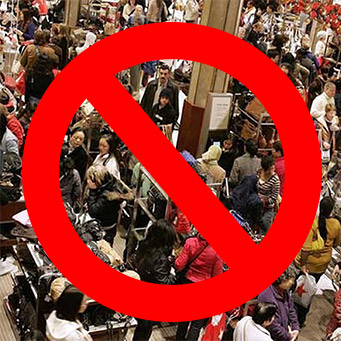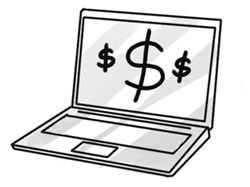I love winter, but everyone around me thinks I’m nuts. Do I know the divine secret to keeping warm all winter? Maybe!
The over-arching theme to all of these tips is to focus your efforts on keeping heat in your house and warming yourself, not your entire house.
Here are 50 ways to feel warmer in your freezing cold house – without spending a fortune. (In fact, most of these tips should save you money in the long haul.)
LET’S GET WARM!!!
20 Free Fixes
Free ways to be warmer?! Sign me up! Even better, some of these tips can save you more than new windows or appliance upgrades ever will!
1. Lower the thermostat
Sure, every “how to save on heating” list starts with this one, but what does it mean? It means if you normally keep your heat at 72 F, drop it to 66 instead. You’ll survive. Heated air is expensive and it likes to escape, so the best thing you can do is to not produce it in the first place.
The rest of the tips on this page will help you live with the lower temp.
2. Bundle your butt up
Double up on socks, get some nice thick slippers, wear a hoodie over a short-sleeve shirt over a long-sleeve shirt. Shirts within shirts, folks, that’s the secret! You get a choice: be bulky or have a bulky heating bill. The first time I got slapped with a $400 bill for the luxury of wearing a T-shirt in January was the last time that happened.

Photo credit: Mark Turnauckas
3. Close your chimney flue
Is it closed all the way? Our flue is stupid and likes to open itself on its own. Leaving a window or a chimney flue open is like opening your wallet and letting dollar bills flutter out.
4. Lock your windows
Locking windows makes the seal a bit tighter. Oh, and duh – don’t leave windows open. If you do open a window to get some fresh air, shut the door to the rest of the house.
5. Keep outside doors tightly shut
Even if you’re stepping outside for just a few minutes, pull that door all the way closed.
6. Minimize use of your kitchen and bathroom fans.
Kitchen and bathroom fans pull lovely heated air out of your home and into the outdoors. (Wallet, fluttering bills…)
7. Wrap yourself in a blanket.
Be a human burrito. It’s winter, no one will judge. If they do, give them a good kick. Kicking warms you up!
8. Rob a bank
Or just pretend you’re going to rob a bank by pulling up the hood on a hoodie. It’ll trap heat and keep you warmer. Bank robbers might suck at being kind to society, but they do save a bit of cash on not having to keep the house so warm.
9. Drop and give me 20!
Pushups or jumping jacks will warm you right up – and help negate the effects of tip #14.
10. Move furniture away from vents
If you’ve got any furniture over or near your heat source, it’s probably soaking up that heat instead of letting it float around the room. Try re-arranging your furniture, if feasible, to work better with the heating vents.
11. Open drapes during the day, close ’em at night
If your summers are hot, you’re probably in the habit of covering your windows to try to keep the rooms a bit cooler. The same principle works in reverse for heating a room: open your drapes and blinds during the day to let heat in, then close ’em up at sunset to keep that heat in.
12. Block door drafts
My first apartment’s doors were the first in the hallway to the outside, so anytime someone came in from outside I’d get a whoosh of icy air under my own door. I wised up and stuck a rolled-up towel at the base of each door. Instant improvement!
If you’re crafty, Not Martha shows readers how to make a pretty DIY door draft stopper. And if you’re not crafty, there’s always something like this As-Seen-On-TV Draft Guard.

DIY draft stopper by Not Martha
13. Take a walk outside
Counter-intuitive, maybe, but a brisk walk in the freezing weather outside warms me up and gives me a new appreciation for the inside temperature.
14. Eat (or drink) something warm
Warm food makes cold temps more tolerable. Food in general kicks up your metabolism, too, so dig in. That’s what I tell myself as I polish off the last of the Christmas cookies.

Photo credit: joyofkosher.com
15. Close the door to unused rooms
If you rarely go into a room, close the door and don’t heat it. Cold air from the unused room won’t mix with the heated spaces. Keeping 1500 sq feet warm instead of 1800 sq feet will save you quite a bit of cash.
16. Raise your door thresholds
If you see daylight under your front door, you’re losing expensive heated air through that crack! That metal bar you step over when you go through the door can usually be made taller to close the gap. Turn the screws counterclockwise until the daylight is mostly gone. Don’t make the door harder to open and close, just shrink the gap a bit.
17. Plug gaps around electrical boxes
Remove the cover plate from an electrical outlet – is there a large gap between the drywall and the electrical box? Most hardware stores sell little sheets of insulation shaped like the outlet cover itself to stick in here. (PS: Don’t pump caulk or foam into the electrical box, that’s bad advice that sometimes shows up in lists like this).
18. Typing gloves!
Don’t heat your whole house just so your tiny fingers can feel warm. DIY typing gloves: cut the fingertips off a pair of cheap garden gloves, and you can still use your keyboard, tablet, and phone while your hands stay roasty toasty. Or, get a nice pair of handmade typing gloves like these from ElenaLittleCreations on Etsy.

Typing gloves by ElenaLittleCreations
19. Roast a chicken
Fire up your oven and bake something huge – your whole house will smell great and feel warm and toasty!

Roasted chicken credit: Elsie Bauer SimplyRecipes
20. Snuggle up close to someone
The world needs more snuggling.
20 Cheap Upgrades
Easy upgrades that cost less as little as a few dollars and no more than $250.
21. Get a space heater
Drop the thermostat, corral everyone into one room, and fire up a space heater for $BIG SAVINGS$. It’s way cheaper to heat just one room via a space heater than it is to heat the whole house.
My family used this space heater trick when I was growing up and I use it in my own place now, and it’s seriously the best. It’s below freezing outside as I write this, but I am toasty warm in my heated computer-room cocoon thanks to the space heater pointed at me.
Don’t have a space heater? Browse Amazon’s full selection of space heaters to find the right one for you.

Here’s a nice portable space heater by Lasko. It doesn’t take a huge space heater to make a room cozy.
22. Install a smart thermostat
No, not a programmable thermostat, unless you promise to program it and use it as intended (most people don’t). Read more about the programmable thermostat energy savings myth here and here.
Keeping the house the same temperature 24/7 is expensive and wasteful, but many people do it. If you have a programmable thermostat, setting it up to lower the temperature during the work day and during the night could save you hundreds of dollars over the heating season.

It’s crazy popular for a reason – the Nest thermostat finds the most efficient heating routine for your home with almost no effort on your part.
23. Change your furnace filter
A dirty filter makes the furnace work harder, which increases the cost to run the thing and wears it out faster. This YouTube video shows how simple it is to change a furnace filter. Measure your existing filter before shopping, since they come in lots of sizes. Change the filter every 6-8 weeks, or whenever it looks really dirty, for the duration of the heating season.
Shop for furnace filters of every size at Home Depot.
24. Upgrade your insulation
You know that fluffy pink stuff that itches like hell if you touch it? Stapling it into your garage, attic, and crawlspace or basement is messy and unpleasant but should save you some cash. Even better, a lot of people have a few rolls of it left over from their own insulation, so ask around – I insulated the walls around my first garage door with some leftover insulation from my parents.
25. Wrap your hot water tank
If your hot water tank is in an unheated part of your home, such as your garage, a water heater insulation blanket might pay for itself very quickly. Many people also report their water is hotter and arrives faster, so there’s that, too.
26. Replace weather stripping
Weather seals compress and wear out over time, making it easier for expensive heated air to escape. ThisOldHouse offers a simple guide for replacing your weather seals.
27. Caulk windows and doors
Depending on your window and door style, a thin bead of caulk applied to cracks between the trim and wall might save you some cash.
28. Locate and fix air leaks
Warm air escaping through tiny cracks and crevices wastes money. Energy.gov offers a guide on detecting air leaks. Keep in mind, though, that you do need some airflow. Blocking everything will cause a moisture build-up, so plug the big ones and then move on.
29. Tape duct cracks
Follow the heating ducts from your furnace: are there any cracks or sags? You may need to seal (or fully replace) your duct work.
30. Give your chimney a pillow
Your chimney(s) are pointed in heat’s favorite direction: up! Plug that thing with an inflatable draftstopping pillow. It’s basically a glorified pool toy for your chimney, and it’s much cheaper than retrofits or new fireplace doors. Sizes vary, so measure before you buy. (PS: Always remove your pillow before lighting any fires.)

Plug your chimney with a chimney pillow and keep heat inside where it belongs!
31. Get a heated toilet seat
One of the worst things about lowering your home’s ambient temperature is having to sit on a cold toilet seat. A heated toilet seat changes everything. I got a UltraTouch Heated Toilet Seat several years ago and it is amazing. One sit and you’re spoiled for life.
32. Apply window film
Heat lost through windows accounts for 10-25% of your heating bill. Covering your windows with clear plastic film (find kits at your local hardware store) can reduce this loss. If you want a really cheap window fix, try this bubble wrap window insulation technique.
33. Get a furnace tune-up
For about $80-$100 a technician inspects your furnace to ensure it is performing at its peak. Doing the maintenance is also a great way to avoid being the proud owner of a dead furnace on Christmas Day, scrambling for your city’s only available repairman.
34. Clean and repair your roof
Moss, leaves, and pine needles retain moisture, so get those things off your roof. Also, repair any existing damage while you’re up there. Replacing damaged shingles and repairing flashing around vent stacks and chimneys will both help your roof last longer and make it a bit more energy efficient.
35. Insulate hot water pipes
Pipes that are warm to the touch should be wrapped to help keep that heat where it belongs (inside the pipe). Pre-slit pipe foam is available at most hardware stores. Just cut to size and fasten it in place with duct tape. The catch? Your pipes are probably in your crawlspace or otherwise awkward to access.

I wrapped my own crawlspace pipes – took a few hours and several yards of foam insulation. Totally worth it – our crawlspace is exposed to the ambient temperature, and no busted pipes yet.
36. Insulate the attic “access door”
Even if you pumped your attic full of blow-in cellulose, if the access door itself doesn’t lay flat or lacks insulation it’s just another way for hot air to escape.
37. Hang thick curtains
Room darkening thermal curtains are a real thing and they are awesome. Open ’em wide during the day, then close ’em up at night. The heavier the curtain, the more it will do to retain heat.
38. …or hang thermal liners
I use a Eclipse Thermal Liners on the back of my bedroom curtains year-round. It makes them heavier, but the liners are very effective at keeping winter heat in and summer heat out.

My Eclipse-brand thermal liner hangs on the backside of my bedroom curtains, which keeps the room dark in the summer and a bit warmer in the winter.
39. Roll out some rugs
Floors can account for up to 10% of your heat loss if they’re not properly insulated. Mitigate heat loss with rugs (or blankets).
40. Hug a heating pad.
A 50-watt heating pad can make winter so much more tolerable for the always-cold among us. This Sunbeam Heating Pad is a family favorite.
10 Long-Term Investments
Here’s the big upgrades: for just a few hundred or thousand dollars, you can help your freezing house be a bit warmer for the rest of all time. Unfortunately, most of these things take a long time to break even on. Still, buying these things make sense if you’re staying a while, or the one you have is already a complete piece of junk, and will help you sell in a buyer’s market.
41. Live in a small home
The practicality of this tip varies by region. Ironically, in my area smaller (1200-1600 sq ft) homes cost just as much, if not more, than larger (1800-2400 sq ft) homes. I think other people are onto this secret. But if you’re choosing between a small home and a larger one, consider the cost to heat the additional space.
42. Replace your furnace
Depending on what you’re replacing, a new model might be way more efficient and could pay for itself in a few years.
43. Install a heat pump
A heat pump isn’t something you just walk into Home Depot and buy – it’s more like a new furnace.
If you live in a climate with mild winters, you’ve probably heard of heat pumps, which move heat rather than generate it. They’re popular here in the Pacific Northwest, and can serve as air conditioning in the summer, but it will will take several years to recover the installation cost.
Read more about heat pumps at Heatpump-Reviews.com.
44. Insulate your attic
Here’s an easy way to tell if your attic insulation isn’t cutting it: icicles are hanging from the edges of your roof. Ice dams and icicles mean there’s heat escaping from your house through your attic – it goes through the roof, melts the snow, and that snow becomes icicles on your gutters.
We insulated our attic with blown-in insulation (it’s a fluffy cellulose material sprayed onto the “floor” of the attic). Our upstairs used to be “the cold floor” of the house: after the blow-in insulation, it’s now the warmest.
45. Increase your home’s thermal mass
Heavy materials retain heat better. Mr. Money Mustache wrote a comprehensive guide on the concept of a home’s “thermal mass” – things to keep in mind when choosing materials for your renovations.
46. Replace your windows
New windows are expensive and messy, but depending on how ancient your windows are you may wait as little as two years for a return on your investment. But most homeowners will wait a lot longer for a return on their window investment (like, a decade). Figure out what windows you have, and compare them to what you’d replace them with, before jumping into a new windows project.
(PS: Windows aren’t just about heat retention. This guide by Andersen Windows points out some of the other advantages of replacing your windows.)
47. Replace your front door
Is your front door super crappy? It might be beyond simple caulking and weatherstripping – replacing the whole door can also improve your resale value (assuming you pick a nice door that suits the house’s design, but you knew that).
48. Insulate your crawl space
Are your floors cold in the winter? The crawlspace under your first floor might be poorly insulated. Explore EnergyStar’s guide on checking your insulation levels for region-specific information. (In the meantime, house slippers help a lot.)
49. Get a tank-less hot water heater
Provides hot water on-demand, and the lack of a tank means hot water isn’t sitting around 22 hours of the day doing nothing. I don’t have a tank-less, but some of my friends do and they love it.
50. Move!
When all else fails, relocate to a warmer climate! I happen to enjoy the cold weather, and I feel bad for people who complain from October to March about the winter season. Las Vegas and Texas are affordable and booming – check ’em out!
Note to readers: Some of the links in this article are affiliate links. They are provided to help you find the recommended product quickly. If you shop through an affiliate link, a tiny % of your purchase (if you make one) helps support this site with a tiny kickback at no cost to you. As always, I encourage you to shop around and price compare to be sure you get the best deal!














